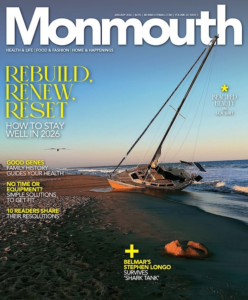New life after a brain tumor
Thanks to a novel chemotherapy regimen, a patient who had a dangerous stage IV brain cancer is back to his active routine.

Paul and Isabel Margolin celebrated their 20th anniversary on August 26 by renewing their vows at the Doo-Wop Diner in las Vegas, with Elvis Presley—or a reasonable facsimile—officiating. Paul told the gathering, “I love this woman, no ifs, ands or buts.” Which is remarkable when you learn that, three years earlier, he had been unable to utter that sentence, a clear indication that his aggressive form of brain cancer was destroying his ability to understand language and putting his life in grave danger.
Today, Paul is virtually tumor-free, thanks to a radical new chemotherapy treatment administered by Sumul N. Raval, M.D., neurologist, neuro-oncologist and founder and medical director of the David S. Zocchi Brain Tu- mor Center at Monmouth Medical Center’s Leon Hess Cancer Center.
Neurologists often ask patients to repeat a phrase or sentence to analyze brain function, Dr. Raval explains. “I chose that sentence because it is a tongue-twister and hard to remember,” he says. “When I saw Paul in 2007 he couldn’t repeat it at all.”
Margolin, of Pine Brook, is a retired electrical engineer who worked as a manufacturer’s representative for 30 years. In the summer of 2007, while on vacation in Cape May, “I started acting strangely,” he says. “My speech wasn’t making any sense.” He was about to go play golf, “but my wife wouldn’t let me. She took me to a hospital there,” he says. An MRI (magnetic resonance imaging) scan found a brain tumor. He was rushed by ambulance to a hospital in Camden, where neurologists diagnosed Stage IV glioblas- toma multiforme, the most common and most aggressive
type of primary brain tumor in humans. (A primary tumor is a tumor that starts in the brain rather than metastasizing from elsewhere in the body.) Surgeons in Camden operated to remove the tumor on July 17.
“He was given about nine months to live,” Isabel says.
He then went on radiation and chemotherapy treatments at the National Institutes of Health in Washington, D.C. But six months later, the tumor was back. The NIH doctors discussed various treatment options, including clini- cal trials. But then a friend recommended Dr. Raval, and Margolin consulted him for a second opinion. “I told him he had a large, serious and rapidly progressing tumor, and I suggested that treatment begin as quickly as possible,” Dr. Raval says.
Dr. Raval offered a new chemotherapy regimen that he had been using very successfully since about 2005. It combines the drug bevacizumab (trade name Avastin), a drug typically used to treat colon cancer, and a second drug used for brain and other cancers called irinotecan (trade names Camptosar and Campto). Dr. Raval has presented and published two papers on this treatment’s effectiveness. It works, he says, because bevacizumab is very effective at breaking through what he calls the blood-brain barrier. “The brain is very good at protecting itself from outside chemicals, including medication,” he says. Researchers like Dr. Raval think bevacizumab gets past that barrier, and brings irinotecan with it. That drug prevents blood vessels from growing into and feeding the tumor, cutting off the tumor’s nutrition supply and, in effect, starving it to death.
The treatment has worked so well that the Food and Drug Administration approved bevacizumab for glioblastoma treatment this year. “It has almost become the new standard of care for these tumors,” Dr. Raval says. “We are very happy and excited to be part of this historic development in cancer care.”
Margolin started his regimen in April 2008. He re- ceived 26 treatments over the next 12 months. “Paul had what we call a CR—a complete response,” Dr. Raval says. “We cannot cure this disease, but his tumor is now almost completely gone. He’s been off the chemo for a year and is essentially tumor-free.”
Margolin needs to get a new MRI every two months to make sure the tumor hasn’t returned. Otherwise, he lives a normal, active life. He and his wife manage a mutual fund and play golf together. “He was a scratch golfer, but now he’s a 12 handicap, much to his annoyance,” Isabel says. They also enjoy time with their five grown children and seven grandchildren. “I have no language problems,” Paul reports. “My memory is a bit less than it used to be, but I’m 75, so that may be normal. I feel like I did before all this happened.”
He even brought Dr. Raval a picture of himself, his wife and Elvis, which Dr. Raval proudly hangs on his office wall. “Most patients do well with this treatment, but not everyone responds like Paul,” he says. “He’s had the most amazing, almost unbelievable results.”

